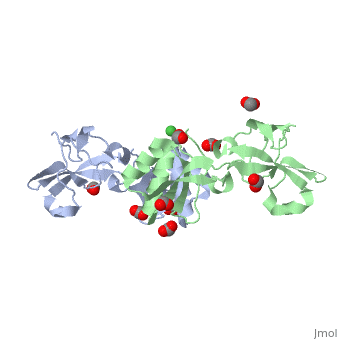Priyanka Basak/Sandbox
From Proteopedia
(Difference between revisions)
| (16 intermediate revisions not shown.) | |||
| Line 1: | Line 1: | ||
| - | == UreE: A Nickel Metallochaperone for Urease == | ||
==Introduction== | ==Introduction== | ||
| - | <StructureSection load='3tj8' size='340' side='right' caption=' | + | <StructureSection load='3tj8' size='340' side='right' caption='''Hp''UreE,PDB ID: 1TJ8 ' scene=''> |
| - | ''Helicobacter pylori'' (''H.pylori'') is a class I human pathogen that is involved in causing gastric ulcers and stomach cancers. Its two nickel dependent enzymes - Urease and NiFe-H2ase, provides it a unique ability to survive and colonize in acidic human stomach. Urease catalyzes the conversion of urea to ammonia and carbamate which neutralizes its local acidic environment. | + | UreE is an essential metallochaeprone for ''Helicobacter pylori'' (''H.pylori''). ''H.pylori'' is a class I human pathogen that is involved in causing gastric ulcers and stomach cancers. Its two nickel dependent enzymes - Urease and NiFe-H2ase, provides it a unique ability to survive and colonize in acidic human stomach. Urease catalyzes the conversion of urea to ammonia and carbamate which neutralizes its local acidic environment. |
== Function == | == Function == | ||
| - | UreE | + | Several accessory proteins play a crucial role in the maturation of Urease. UreE is a urease-specific nickel metallochaperone that is involved in the delivery nickel to urease. |
| - | + | ||
| - | + | ||
| - | + | ||
| - | + | ||
== Structural highlights == | == Structural highlights == | ||
| - | Apo-UreE from ''H.pylori'' is a dimer | + | Apo-UreE from ''H.pylori'' is a dimer.''Hp''UreE can bind one Ni(II) per dimer <scene name='60/609775/Nickel_bound_uree/5'>Nickel bound UreE</scene>. Nickel is bound to UreE in an octahedral fashion with one His from one subunit and two His from other subunit <scene name='60/609775/Nickel_bound_uree_2/2'>(UreE-Nickel Binding site)</scene>.In presence of Ni, its oligomeric state changes to a tetramer (dimer of dimer). |
| - | + | ||
| - | + | ||
| - | + | ||
| - | </StructureSection> | ||
== References == | == References == | ||
| - | < | + | <http://www.ncbi.nlm.nih.gov/pubmed/20681615/> |
[http://] | [http://] | ||
Current revision
Introduction
| |||||||||||

